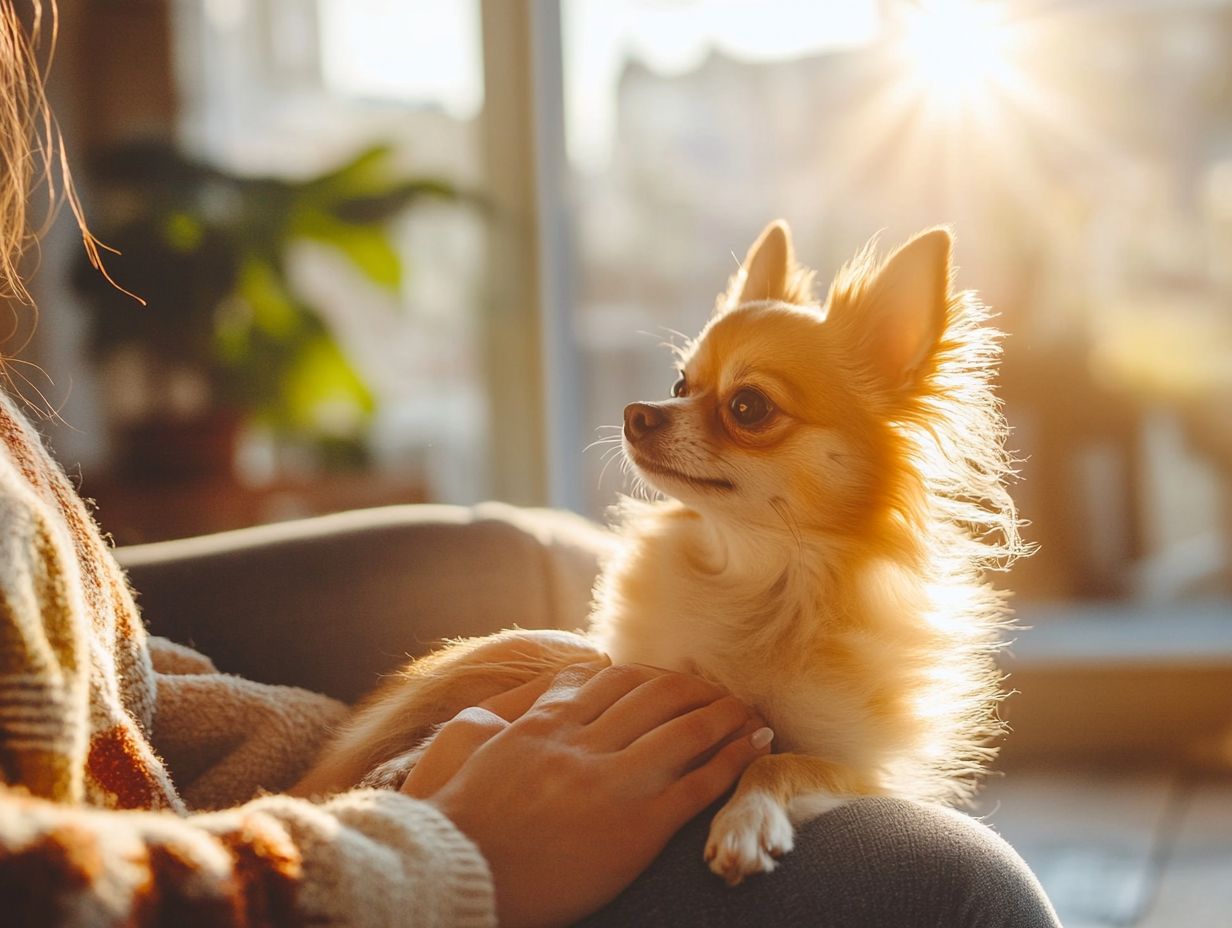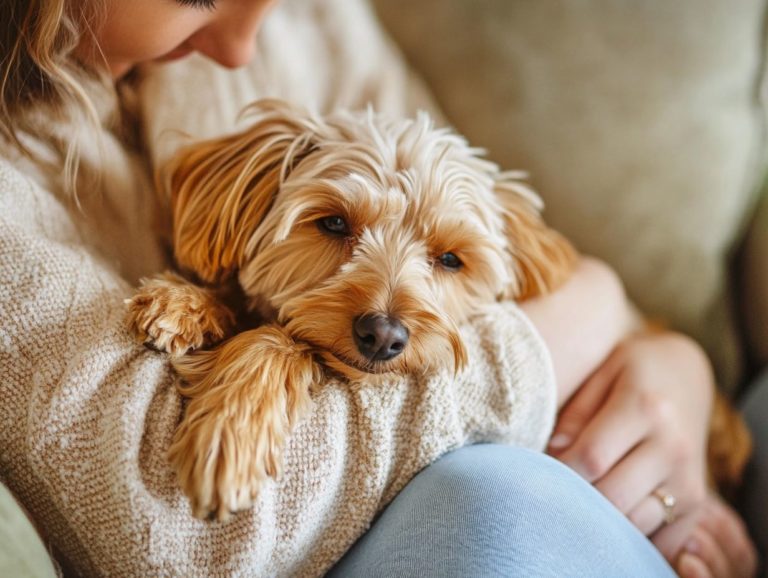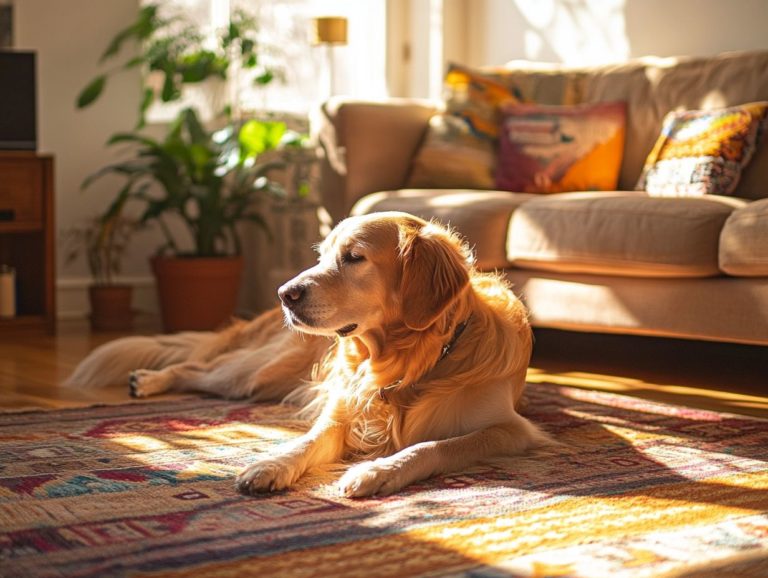What Should I Do If My Pet Develops Anxiety Suddenly?
Pet anxiety can be a challenging experience for both you and your furry companion. Understanding the underlying causes and identifying specific triggers are essential first steps in tackling this issue.
This guide will assist you in recognizing the signs and symptoms of pet anxiety, enabling you to observe any behavioral changes in your beloved friend.
You ll discover effective strategies to create a calming environment, explore natural remedies, and identify when it s time to seek professional assistance.
You ll also learn preventive measures to help your pet feel secure and happy. Continue reading to empower yourself in fostering a stress-free setting where your cherished companion can truly thrive.
Contents
- Key Takeaways:
- Understanding Pet Anxiety
- Signs and Symptoms of Pet Anxiety
- How to Help Your Pet Cope with Anxiety
- When to Seek Professional Help
- Preventing Anxiety in Pets
- Frequently Asked Questions
- What Should I Do If My Pet Develops Anxiety Suddenly?
- What are the common signs of anxiety in pets?
- Should I take my pet to the vet if they develop anxiety suddenly?
- Can I use natural remedies to help my pet s sudden anxiety?
- What are some ways to prevent sudden anxiety in pets?
- How can I help my pet feel more secure during an anxiety episode?
Key Takeaways:

- Know the common causes and triggers of pet anxiety to better understand your pet’s sudden change in behavior.
- Be aware of the signs and symptoms of pet anxiety, such as changes in behavior, to identify and address the issue promptly.
- Provide a safe and calm environment for your pet, and consider using natural remedies. Seek professional help if the anxiety is severe or persistent. Take preventive measures to help prevent anxiety in your pet.
Understanding Pet Anxiety
As a dedicated pet parent, understanding pet anxiety is key to helping your furry friend through tough emotional times. Dogs experience anxiety much like humans do. It can show up in various ways, often triggered by specific events like fireworks or thunderstorms.
Recognizing the different symptoms of anxiety is your first step toward effective management. This means looking into the causes of the anxiety and adjusting your dog s environment to create a calming, nurturing space.
Causes and Triggers
Many factors can trigger your dog’s anxiety. These can range from sudden changes in their environment to health concerns, like conditions that affect memory and behavior, which can heighten their fear response.
For example, you might notice your dog experiencing separation anxiety when left alone, leading to destructive behaviors and excessive barking. Environmental triggers, such as thunderstorms and fireworks, can cause intense fear, prompting some dogs to seek shelter or try to escape.
Health issues, like arthritis or hormonal imbalances, can also increase anxiety, as pain and discomfort often lead to emotional distress.
To address these challenges effectively, it’s essential to consult with veterinarians who can recommend appropriate treatments, which may include:
- Calming medications
- Behavior modification strategies
- Training techniques to create a secure and reassuring environment for anxious dogs
Signs and Symptoms of Pet Anxiety
Recognizing the signs and symptoms of pet anxiety is crucial for you as a pet parent. It allows for timely intervention. An anxious dog might show various symptoms, like destructive behavior, excessive barking, or withdrawal from social interactions.
By understanding these signs, you can implement effective stress relief techniques that enhance your dog’s overall well-being.
Recognizing Behavioral Changes

Noticing behavioral changes in dogs can be a crucial indicator of underlying anxiety issues. Anxious dogs may show altered behaviors, such as increased aggression or fearfulness. These changes can stem from anxiety symptoms linked to various stressors.
Understanding these changes is vital, as they often act as early alerts to emotional distress that requires your attention. For example, if your dog usually enjoys socializing but suddenly shies away from other pets or people, it s a clear sign of sudden anxiety that needs closer observation.
Behavioral modification techniques, like positive reinforcement training or gradual desensitization to triggers, can be invaluable in helping anxious dogs adjust. By using these methods, you can create a supportive environment that helps your furry companion feel safe and secure, fostering healthier behaviors in the face of anxiety.
Don’t wait! Start recognizing your pet s anxiety signs today for a happier, healthier companion.
How to Help Your Pet Cope with Anxiety
Helping your pet cope with anxiety requires a thoughtful approach. Combine treatment strategies with effective anxiety management techniques.
Incorporate calming elements like soothing music from PetTunes or DogTV. These can help create a serene environment for your anxious dog.
Provide mental stimulation to engage your anxious dog. This helps keep them occupied and reduces stress.
Creating a Safe and Calm Environment
Create a safe, serene environment to help your anxious dog thrive! This is vital for managing their behavior and easing stress.
Designate a calm space as a sanctuary for dogs dealing with separation anxiety or other triggers. This retreat allows them to feel secure.
This tranquil space should include soft bedding for comfort and warmth, helping ease muscle tension. Incorporate soothing scents like lavender or chamomile to enhance relaxation.
Keep noise levels low through soundproofing or gentle background sounds. Excessive noise can be a significant stressor.
All these elements create a refuge where dogs can unwind. This fosters a positive atmosphere that aids in stress relief and improves behavior.
Using Natural Remedies
Natural remedies, such as CBD oil and calming music, can effectively manage your dog’s anxiety. Combine these with professional guidance from your veterinarian to enhance your approach.
Consider incorporating essential oils like lavender and chamomile for a soothing environment. Engage in holistic approaches like yoga for dogs or simple breathing exercises to reinforce relaxation.
Gentle canine massage techniques not only alleviate stress but also strengthen your bond with your pet.
Recognize each dog is unique. Understand their triggers and preferences, including potential health issues like Urinary Tract Infection or pancreatitis. This knowledge helps craft a tailored plan.
Consulting with a vet ensures safety and allows you to integrate these natural strategies into a supportive framework that promotes your dog s overall well-being.
When to Seek Professional Help

Know when to seek professional assistance for your pet’s anxiety, especially if you’re unsure of how to help. If your pet is anxious during grooming, knowing what to do can make a difference, so don’t wait to act!
As a dedicated pet parent, remain vigilant for severe anxiety signs, including those stemming from cognitive dysfunction.
Watch for persistent destructive behaviors or escalating symptoms. These may indicate cognitive dysfunction or other underlying health issues.
Identifying Severe Cases
Identifying severe anxiety in dogs is crucial for preventing further distress. Notice symptoms like extreme destructive behavior or severe separation anxiety. It may be time to consult a veterinarian or an animal behaviorist.
Neglecting these signs can harm your dog s mental health and well-being. Other noticeable behaviors, such as excessive barking, drooling, trembling, or attempts to escape, can signal serious anxiety issues.
When you observe these symptoms, seek support from professionals like veterinarians or animal behaviorists. These specialists conduct thorough assessments and provide insights into underlying causes, including cognitive dysfunction syndrome.
They can develop a tailored treatment plan that may include behavioral therapy or medication.
In the meantime, help ease your dog s anxiety by establishing a routine, creating a safe space, and employing positive reinforcement techniques.
Preventing Anxiety in Pets
Preventing anxiety in pets calls for active steps from you as a pet parent, aimed at fostering positive behavior and encouraging socialization among dogs to help reduce the chances of developing anxiety symptoms. By implementing these preventive measures, you can significantly diminish the chances of anxiety taking root in the first place.
Preventive Measures and Tips
Implementing preventive measures and tips can enhance your dog’s emotional stability and reduce the likelihood of anxiety symptoms. Engaging in regular socialization and exposing your dog to new environments can bolster their confidence and improve their overall behavior.
Incorporating gradual exposure techniques allows your dog to confront potential anxiety triggers at their own pace, minimizing stress responses. Positive reinforcement rewarding good behavior with treats or praise plays a crucial role in this journey, encouraging desired behaviors while fostering a positive association with new experiences.
Establishing consistent routines and engaging activities, such as daily walks or puzzle toys, provides mental stimulation and helps your dog feel secure in their surroundings. By being attentive to body language and emotional cues, you can tailor your approach to suit each individual dog, ensuring a supportive environment that promotes emotional well-being and balanced behavior.
Frequently Asked Questions

What Should I Do If My Pet Develops Anxiety Suddenly?
If your pet suddenly starts exhibiting signs of anxiety, it can be quite alarming. Here are a few steps you can take to help ease your pet’s anxiety, including checking out what to do if your pet is anxious after moving:
What are the common signs of anxiety in pets?
The signs of anxiety in pets can vary, but some common ones include excessive barking or meowing, destructive behavior, changes in appetite, hiding, and pacing. If you notice any sudden changes in your pet’s behavior, it’s important to pay attention and refer to what you should know about anxiety in senior pets to take action.
Should I take my pet to the vet if they develop anxiety suddenly?
It’s always a good idea to consult with your veterinarian if you notice sudden changes in your pet’s behavior. They can rule out any underlying medical issues and provide guidance on what to do if your pet’s anxiety worsens.
Can I use natural remedies to help my pet s sudden anxiety?
There are many natural remedies that can help ease your pet s anxiety, such as essential oils, pheromone diffusers, and calming treats. However, it s important to consult with your vet before trying any new remedies to ensure they are safe for your pet.
What are some ways to prevent sudden anxiety in pets?
While some pets may develop anxiety due to underlying medical or behavioral issues, there are preventive measures you can take to help reduce the likelihood of sudden anxiety. If you’re concerned about your pet’s stress levels, it’s helpful to know what to do if your pet gets anxious in public. To help prevent sudden anxiety, provide regular exercise, maintain a consistent routine, and stimulate your pet mentally.
How can I help my pet feel more secure during an anxiety episode?
During an anxiety episode, it’s important to help your pet feel safe and secure. This can include providing a quiet and comfortable space, using soothing techniques like massage or music, and offering reassurance and affection to your pet. However, knowing when to consult a professional for pet anxiety can also be crucial for their well-being.
For further assistance with your pet’s anxiety, don’t hesitate to contact your veterinarian. They can provide tailored advice and support, and you might also find helpful information in our guide on what you should know about therapy for anxious pets.






